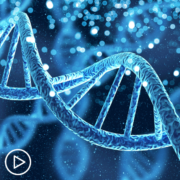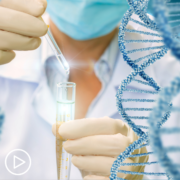What Are the Advantages of Seeking Care With a Lung Cancer Specialist?
What Are the Advantages of Seeking Care With a Lung Cancer Specialist? from Patient Empowerment Network on Vimeo.
What are the benefits of seeing a lung cancer specialist? Dr. Thomas Marron discusses the key advantages of specialty care, the value of a second opinion, and options for seeing a lung cancer specialist via telemedicine.
Dr. Thomas Marron is Director of the Early Phase Trials Unit at the Tisch Cancer Institute at Mount Sinai Hospital. Dr. Marron is also Professor of Medicine and Professor of Immunology and Immunotherapy at the Icahn School of Medicine at Mount Sinai. Learn more about Dr. Marron.
See More from EVOLVE Lung Cancer
Related Resources

Advances in Targeted Lung Cancer Treatments | What You Should Know |

Antibody Drug Conjugates for Lung Cancer | Advances in Research |

Lung Cancer Treatment Plan Advice | Where Do Clinical Trials Fit In? |
Transcript:
Katherine Banwell:
What’s the advantage then of seeking care with a lung cancer specialist?
Dr. Thomas Marron:
So, I think it’s extremely important. Unfortunately, a lot of the country, there are not lung cancer specialists available around the corner. But in large cities, there’s typically many lung cancer specialists, but I think it’s extremely important, at least as a second opinion, even if you’re not going to be treated locally by a lung cancer specialist, to seek out expertise.
And often times, I’ll have patients that come from more rural areas outside of New York and they’ll come, and they’ll see me and then I’ll work with their local provider to come up with a treatment plan. Because the fact of the matter is, is that in every cancer type, but particularly in lung cancer, the field is moving so quickly. So, the treatment options that we have available today were not available in 2022.
And we’re going to have probably five to 10 drugs that’re going to be FDA-approved in the next year. And it’s typically the lung cancer specialist where it’s all that we do, we eat, breathe and live lung cancer, we’re the ones that really are up to date on everything. While if you’re seeing a general hematology, oncology provider who I’m always in awe of, they have to stay up to date on lung cancer, breast cancer, lymphoma, leukemia, everything under the sun.
And when you have so much development in the research that’s happening, you really want to be talking to somebody, at least as a second opinion that knows exactly what the most latest data is and what the best options are available. And also, those lung cancer providers are usually the ones that will know exactly where you can go to get access to certain clinical trials.
Katherine Banwell:
In seeking a second opinion, can somebody do a tele-visit, or do you have to actually, physically go to see the specialist?
Dr. Thomas Marron:
So, it depends on the specialist that you’re trying to see.
There are certain institutions that will allow you to do televisits. Oftentimes doctors, at least for their first encounter with a patient really want to see somebody in person, just so that we can really evaluate how functional somebody is. There’s a lot that I cannot tell through my computer screen, through my Zoom call with a patient.
And so, it can be a little bit difficult, but there are many centers, including our own that will offer patients televisits as a second opinion, for us to get a chance to talk to them about their medical history, review, the treatment decisions that they’ve had in the past or the current treatment decision that they’re dealing with and give our own opinion on what they should do.
Lung Cancer Treatment Plan Advice | Where Do Clinical Trials Fit In?
Lung Cancer Treatment Plan Advice | Where Do Clinical Trials Fit In? from Patient Empowerment Network on Vimeo.
What questions should patients ask about a lung cancer treatment plan? Lung cancer expert Dr. Thomas Marron shares key considerations when choosing therapy and discusses where clinical trials fit into planning.
Dr. Thomas Marron is Director of the Early Phase Trials Unit at the Tisch Cancer Institute at Mount Sinai Hospital. Dr. Marron is also Professor of Medicine and Professor of Immunology and Immunotherapy at the Icahn School of Medicine at Mount Sinai. Learn more about Dr. Marron.
See More from EVOLVE Lung Cancer
Related Resources
Transcript:
Katherine Banwell:
What questions should patients be asking about their proposed treatment plan?
Dr. Thomas Marron:
I think that in lung cancer, most patients are going to get the same therapeutic approach offered to them wherever they go.
It’s not like certain types of cancer where there’s 10 different ways to treat it. But there are some nuances and depending on the location in which you’re getting treated, whether it be in an academic hospital or a community setting, you may have different chemotherapies offered, immunotherapies offered. You may have different combinations offered. And so, I think it’s important to always ask your provider what other options are there, and why are they recommending one option over another. But I think it’s also really important that patients get second opinions.
A lot of my patients, even my in-laws are always very skittish about getting a second opinion because they don’t want to insult their doctor, who they feel very close to. And I would say, it couldn’t be further from the truth. Any good doctor is 100 percent okay with a patient going and getting a second, third, fourth opinion because to us, the most important thing is that you have confidence in the decisions that we’re making about your treatment.
I always tell patients, I’m basically a waiter here offering you a menu of options and giving you my recommendation. But it is up to the patient in the end what treatment they receive and how long they receive it for.
And if they decide ever to discontinue it. And I think that the more information, the more smart people looking at you, the better.
Katherine Banwell:
Where do clinical trials fit into a non-small cell lung cancer treatment plan?
Dr. Thomas Marron:
So, that’s a phenomenal question and one that I hope that everyone asks their providers when they see them because the reality is that while we are curing some patients, the vast majority of patients are not cured. And I think that all patients should at least consider a clinical trial, whether it be a first line clinical trial. So, the first medicine that you receive for your cancer, or at the time of progression.
I think particularly, once patients progress on the first line therapy, those patients we really don’t have a cure for, even if we have some palliative chemotherapies or eventually these antibody drug conjugates to treat them.
And so, I think everybody who is progressing on first line therapy should always consider a clinical trial. And I think it’s extremely important that patients realize the need to ask their providers about clinical trials, but also be an advocate for themselves and go out and get second opinions, get third opinions and see what trials are available in the community and even in other cities.
Because often times in New York City, I’ll have completely different clinical trials than my colleagues at the other five institutions in the city. And it’s really important that patients advocate for themselves, and they identify everything that’s available.
Expert Perspective | New and Emerging Progress in Lung Cancer Treatment
Expert Perspective | New and Emerging Progress in Lung Cancer Treatment from Patient Empowerment Network on Vimeo.
What’s the latest in lung cancer research? Dr. Thomas Marron from the Tisch Cancer Institute at Mount Sinai Hospital discusses the advances in targeted therapy and immunotherapy and what this progress means for patients with lung cancer.
Dr. Thomas Marron is Director of the Early Phase Trials Unit at the Tisch Cancer Institute at Mount Sinai Hospital. Dr. Marron is also Professor of Medicine and Professor of Immunology and Immunotherapy at the Icahn School of Medicine at Mount Sinai. Learn more about Dr. Marron.
See More from EVOLVE Lung Cancer
Related Resources

Advances in Targeted Lung Cancer Treatments | What You Should Know |

Antibody Drug Conjugates for Lung Cancer | Advances in Research |

Lung Cancer Treatment Plan Advice | Where Do Clinical Trials Fit In? |
Transcript:
Katherine Banwell:
Dr. Marron, you’re a leading researcher in the field. What new and emerging progress in lung cancer care are you excited about?
Dr. Thomas Marron:
So, there’s many extremely exciting, targeted therapies that’re in development. And so, as I mentioned, we do genetic sequencing, and we get three to 500 genes’ worth of data. But we only have drugs to target around 10 of those.
So, hopefully in the coming years, in the next three to five years, we’ll have many more options based on somebody’s genetic profile of their tumor. I think that also, within the field of immunotherapy, which typically are given to patients who don’t have those targetable mutations.
Immunotherapy is really, has revolutionized the treatment of lung cancer and with immunotherapy, we’re actually able to cure a subset of patients while in the past, we always said patients with metastatic disease had incurable disease, but it was treatable disease, just not curable.
Now, we are curing a subset of patients. Unfortunately, we’re not curing the majority of patients. But the field of immunotherapy is evolving very quickly with new therapies targeting new parts of the immune system.
So, similar with targeted therapies, it’s really an umbrella term. So, targeted therapy is an umbrella term for dozens of different drugs. Immunotherapy, similarly, is an umbrella term for dozens of different approaches to the immune system. So, dozens of different ways to turn on the immune system so that the immune system does its job and recognizes and kills cancer. Because your immune system is in your body to tell the difference between foreign things like COVID and normal things like your lung.
And cancer is somewhere in between and there’s probably hundreds of different ways in which cancer finds an ability to hijack our immune system and then turn our immune system off. And so, I think with these emerging therapies that we’re developing now and will be further developed in the next five to 10 years, I think we’re going to see another revolution happen in the setting of immunotherapy.
Katherine Banwell:
So, what do these advances mean for non-small cell lung cancer patients?
Dr. Thomas Marron:
So, in non-small cell lung cancer, immunotherapy has really changed the way that we’re treating patients from 10 years ago when we were giving chemotherapy alone, or maybe 15 years ago. Ten or 15 years ago, when I saw a patient with metastatic disease, I would have to have a very frank conversation with them and tell them that the median survival was 10 months and that this was an incurable illness that would eventually take their life. Now, with the introduction of immunotherapy, patients are living more than twice as long on average.
And there are a subset of patients, somewhere between 10 to 20 percent of people that go into remission and stay in remission. And so, that really has revolutionized the treatment. Obviously, we’re not done, because we still have to help the remainder of those patients and our goal is 100 percent cure. But the fact that we’re even using the C-word, cure in our cancer clinics is really amazing.
Antibody Drug Conjugates for Lung Cancer | Advances in Research
Antibody Drug Conjugates for Lung Cancer | Advances in Research from Patient Empowerment Network on Vimeo.
What are antibody drug conjugates, and how are these new agents changing lung cancer care? Lung cancer expert Dr. Thomas Marron defines antibody drug conjugates and explains how they work to treat lung cancer.
Dr. Thomas Marron is Director of the Early Phase Trials Unit at the Tisch Cancer Institute at Mount Sinai Hospital. Dr. Marron is also Professor of Medicine and Professor of Immunology and Immunotherapy at the Icahn School of Medicine at Mount Sinai. Learn more about Dr. Marron.
See More from EVOLVE Lung Cancer
Related Resources

Advances in Targeted Lung Cancer Treatments | What You Should Know |
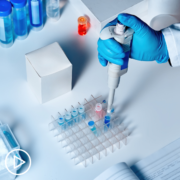
|
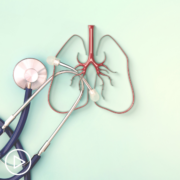
Expert Perspective | New and Emerging Progress in Lung Cancer Treatment |
Transcript:
Katherine Banwell:
What are antibody drug conjugates, and how do they treat lung cancer?
Dr. Thomas Marron:
So, antibodies are proteins that have been manufactured. They’re a synthetic version of something that happens in our own body And they’re very specific for a very unique protein. And so, there are certain cancer proteins, there’s proteins on the surface of cancer that really aren’t expressed anywhere else in your body. And so, what we can do is we can develop these antibodies that basically are a heat-seeking missile. So, you inject them like chemotherapy, through an IV. But they’re a heat-sinking missile, and they go throughout your body, and they stick themselves to the cancer.
And hopefully, they don’t stick anywhere else. And basically, antibody drug conjugate means the drug is conjugated to the antibody, meaning you basically have glued chemotherapy onto that antibody.
And so, what it allows us to do is, instead of giving chemotherapy through the IV like we normally would, where that chemotherapy goes everywhere in your body, and that’s the main reason that you have toxicity.
It doesn’t just go to the cancer, it also goes to your bone marrow, to your hair, to your intestines, has side effects. Antibody drug conjugates, the goal of them is to really deliver the chemotherapy directly to the tumor and spare the rest of your body, the toxicity from the chemotherapy that’s glued onto the antibody.
It’s important to note that they still do have side effects. So, some of that chemotherapy, for lack of a better term falls off the antibody or it might leak out of the tumor after it kills the tumor cells. And so, there is still the potential for toxicity, very similar to the toxicities that we see with chemotherapy.
But so far, the data is very encouraging, both in lung cancer and other cancer types that antibody drug conjugates might be a superior formulation of chemotherapy, so better able to treat lung cancer. And we have a few drugs that’re actually probably going to be FDA-approved in the second line setting for non-small cell lung cancer. So, that’s for patients who have received standard first-line therapy and unfortunately, their cancer has progressed.
And we actually already have one drug that was, it’s called Enhertu that was developed for breast cancer. And that’s now FDA-approved for lung cancer, for a rare subset of lung cancer patients who have an exon-20 HER2 mutation.
And the patients I’ve treated with that drug do extremely well, and so I think it’s a very encouraging sign of what’s to come using more and more of these targeted chemotherapy regimens.
Katherine Banwell:
Yeah. Well, that leads me to the next question, is there a patient type that ADCs are right for?
Dr. Thomas Marron:
So, maybe is the question, answer. So, I don’t know because we don’t have good biomarkers right now to identify the patients that’re going to respond best to the drugs that’re in development, at least those ones that’re furthest along in development.
And we’re always searching for biomarkers, which basically just means a test that we do on the patient’s biopsy or in their blood to tell us who’s going to respond to a therapy and who’s not. Unfortunately, right now we don’t have a good biomarker for these drugs.
Hopefully as we do larger trials and we study biopsies and blood from the patients on those trials, we can identify the subset of patients that will do best with the therapy. Because we always want to make sure we’re getting patients the best therapy for them and we’re avoiding giving these therapies, because there are some toxicities to patients that aren’t going to respond to the therapy. So, it’s definitely a work in progress.
How Has Lung Cancer Molecular Testing Evolved?
How Has Lung Cancer Molecular Testing Evolved? from Patient Empowerment Network on Vimeo.
What are the latest advances in lung cancer testing? Dr. Thomas Marron discusses the role of molecular testing when choosing therapy and how innovations in technology have revolutionized lung cancer care.
Dr. Thomas Marron is Director of the Early Phase Trials Unit at the Tisch Cancer Institute at Mount Sinai Hospital. Dr. Marron is also Professor of Medicine and Professor of Immunology and Immunotherapy at the Icahn School of Medicine at Mount Sinai. Learn more about Dr. Marron.
See More from EVOLVE Lung Cancer
Related Resources
Transcript:
Katherine Banwell:
What should patients understand about the results of molecular testing?
Dr. Thomas Marron:
So, molecular testing is extremely important and anybody who has metastatic non-small cell lung cancer should get it. And increasingly, with the new drug approvals, even patients that have earlier stage disease, stage II and III disease should also get molecular testing. Molecular testing is important to identify if there is a potential therapeutic target.
But it’s also important to know that it may predict a response to a therapy, whether that be a targeted therapy or something like immunotherapy. But there is no guarantee. So, there’s no specific result from a molecular test that tells you there’s 100 percent chance you’re going to be cured by Drug X.
And so, it’s important to always know that we’re following the data and we’re giving patients the drugs that, based on the knowledge we have today is the best option for them, based on their molecular test. But it isn’t a guarantee. And sometimes these drugs will work transiently.
And so, they may work for weeks, months, year but then they might stop working. And it’s also important to understand that the mutational profile may change over time, which is one of the reasons why we do these genetic tests. Oftentimes multiple times. Not just at the time of diagnosis, but also when patients’ cancer starts to grow so that we can see if there’s a new molecular target that we might be able to identify and treat with a novel therapy.
Katherine Banwell:
Dr. Marron, are there innovations in technology that are aiding in the advancement of lung cancer research?
Dr. Thomas Marron:
Yeah, so there’s lots of developments in the molecular tests that we’re doing. One of them is that we’re able to track circulating tumor DNA. So, as cancer is growing, it grows in this very unorganized aberrant way, because the on and off growth switches within the cancer, within the DNA are very dysregulated. And what happens is that often times, they’re releasing a lot of cancer cells as they’re growing or also dying and releasing their DNA into the blood.
And so, through blood tests, we’re now able to identify the mutations in a patient’s cancer. And this is a real revolution in the initial diagnosis of metastatic lung cancer because in the past, we had to wait for three, four, five weeks in order to know whether a patient had a targetable mutation like an EGFR mutation. Or if we should use a more agnostic approach, immunotherapy or chemotherapy to treat the patient.
But now when I see a patient, typically I see lung cancer patients on Fridays, I will take some of their blood, I send it off for the liquid biopsy analysis. And by that following Friday, so just one week later, I typically have an answer of if the patient has a mutation that I can target, let’s say with an oral medicine or if they’re a patient that I should be treating with immunotherapy. Additionally, circulating tumor DNA, increasingly we can use it to identify or track a patient’s progress, as far as response to therapy.
And so, this has really been developed in other tumor types, but increasingly we’re using it in lung cancer where we can either track how much cancer they have in their body. So, very early on, we can see if the cancer is shrinking or growing. And additionally, we can use it to detect patients after surgery, whether or not they have residual disease in their body.
And so, a lot of the times patients will undergo surgery because let’s say on a CAT scan, you might only see one large, isolated tumor. But after we take that tumor out, now we can do a blood test to see if there might be microscopic bits of that cancer that were left over, that we weren’t able to see on a CAT scan or PET scan.
And it’s that patient population that we think benefits most from either chemotherapy or targeted therapy after surgery. So, we’re using circulating tumor DNA, both in the metastatic setting, where cancer has already spread to other parts of the body. And also, in the perioperative setting, around the time of surgery or radiation where we’re trying to cure patients. And we’re now able to use this technology to hopefully increase the likelihood that we’re curing them.
Advances in Targeted Lung Cancer Treatments | What You Should Know
Advances in Targeted Lung Cancer Treatments | What You Should Know from Patient Empowerment Network on Vimeo.
Dr. Thomas Marron discusses how these therapies work to treat lung cancer, how the presence of certain mutations can impact care and treatment choices, and the research being done on new therapies to target specific lung cancer biomarkers.
Dr. Thomas Marron is Director of the Early Phase Trials Unit at the Tisch Cancer Institute at Mount Sinai Hospital. Dr. Marron is also Professor of Medicine and Professor of Immunology and Immunotherapy at the Icahn School of Medicine at Mount Sinai. Learn more about Dr. Marron.
See More from EVOLVE Lung Cancer
Related Resources:

|

Antibody Drug Conjugates for Lung Cancer | Advances in Research |

Expert Perspective | New and Emerging Progress in Lung Cancer Treatment |
Transcript:
Katherine Banwell:
Welcome, Dr. Marron. Would you introduce yourself, please?
Dr. Thomas Marron:
Sure, I’m Tom Marron. I’m the Director of the Early Phase Trials Unit at the Tisch Cancer Institute at Mount Sinai Hospital. I’m a Professor of Medicine and also a Professor of Immunology and Immunotherapy at the Icahn School of Medicine at Mount Sinai. And I’m trained as both an oncologist and an immunologist.
Katherine Banwell:
Excellent. Thanks for joining us today.
Dr. Thomas Marron:
Thank you for having me.
Katherine Banwell:
We know that the presence of certain mutations can affect lung cancer treatment options. Can you share the latest updates in targeted therapies?
Dr. Thomas Marron:
Sure, so there’s been a lot of developments in targeted therapies as of late.
Mutations in a patient’s cancer can represent a potential therapeutic target, and we have increasing numbers, every year we have new FDA approvals for typically pills that target very specific mutations and are able to either control cancer or even kill cancer. Additionally, we use DNA sequencing of tumors to identify mutations that could be predictive of a response to certain therapies. So, even though we don’t have a specific drug to target that mutation in their DNA, that change in their DNA that’s making the cancer grow, we do know that patients with certain DNA mutations do better on certain therapies than other therapies.
And so, we can use mutations specifically to help guide therapy, even if we don’t have a targeted therapy for something like EGFR mutation or a KRAS mutation. And additionally, one of the things that we do as we’re treating patients is, often times we will give a patient with lung cancer a therapy and then their cancer may respond for weeks, months, even years.
But then it might recur, or it might just start growing if it never went away entirely. And at that time, we’re oftentimes repeating the genetic sequencing, whether doing a biopsy or sometimes we can do what we call a liquid biopsy, which is just taking some blood and looking for some of the DNA from the cancer floating around in the blood.
And the reason we do that is that if you see a change in the mutations, it might represent either a change in the type of cancer or it might represent what we call an escape mutation, or an escape mechanism where the cancer that had been responding to therapy X is now not responding because it changed its DNA to overcome the therapy you were given. And that might suggest that we try a specific new therapy, or that we just change our approach entirely.
Katherine Banwell:
You’ve answered my next question to some degree, but I’m going to ask it anyway. How do these therapies work to treat lung cancer?
Dr. Thomas Marron:
So, cancer is caused by changes in your DNA. So, your DNA is your instruction booklet on how cells should grow and when they should grow. And every cell in your body theoretically has the same DNA, except for, because of a variety of things like smoking or exposure to radon or just living in a large city full of pollution. As we get older, we basically accrue more and more mutations and changes in our DNA, our instruction booklet. And while most of these changes really don’t have any sequela, and they’re not going to affect the ability for the cancer, or for normal cells to grow.
Sometimes you’ll get a mutation in a very specific gene that’s important for telling cells when to divide and when to grow and when not to grow. And you can think of it as a light switch where the light switch gets stuck in the on position and constantly, cells are growing and growing and growing and that’s when you have cancer. So, when you have these mutations, one of the approaches that we’ve been working on for the last few decades, in particular in the last few years.
We have lots of these new drugs that target these mutations, and they basically turn that on signal off. So, they disrupt, it’s like turning the light switch off. You’re disrupting the constant grow, grow, grow signal and keeping the cancer from growing. Typically, we think of these targeted therapies that do this, not as cures for cancer, at least when patients have metastatic disease, but they’re very good at controlling cancer. And some of these therapies can work for years, even a decade and control the cancer. But often times, unfortunately cancer always finds a way to outsmart us, even when we’re outsmarting it.
Katherine Banwell:
Right. Are there new mutations being discovered that can impact the future of small cell lung cancer care?
Dr. Thomas Marron:
Well, I’m not sure I would say that there’s a lot of new mutations that’ve been discovered, per se. Every time that you come in and get a diagnosis of lung cancer, we typically will take the tissue and like I said, sometimes we’ll take some blood and do a liquid biopsy and look for a slew of different known mutations.
And typically, we’ll look for anywhere from three to 500 known mutations in the cancer, even though we only have drugs to treat about 10 of those three to 500. The nice thing though is that as we learn more and more and more about these mutations and we study them, we are developing more and more drugs to address specific mutations. So, five years ago we really only had three different mutations that we could target.
Now, we have around 10 because we have all these new drugs that target very specific mutations whether they be in genes like MET or RET or KRAS or BRAS.
So, I think that while we aren’t necessarily discovering that many new genes, we’ve been looking at the genetic sequence of cancer and also, just the human genome for 20 to 30 years at this point, we’re discovering lots of new drugs that can target those specific mutations that we know patients have, but that most of the mutations we identify are not necessarily druggable targets.
How Can We Leverage Lung Cancer Biomarker Data to Address Health Disparities
How Can We Leverage Lung Cancer Biomarker Data to Address Health Disparities? from Patient Empowerment Network on Vimeo.
How can biomarker disparities be overcome by data collection? Experts Dr. Joshua Sabari from NYU Langone and Dr. Eugene Manley from SCHEQ Foundation discuss the status of biomarker data sharing, biobanks, and improvements that can be made toward the future.
Download Resource Guide | Descargar guía de recursos
See More from [ACT]IVATED NSCLC Biomarkers
Related Resources:
Transcript:
Lisa Hatifeld:
Are there any national or international databases that collect information from those biopsies, like a biopsy data bank of some kind so they can look at this disparate group of mutations? Or is it just institutional, like if an institution collects that tissue, they keep that information? I’m just wondering if that could help in any way with the disparities we see in those biomarkers.
Dr. Joshua Sabari:
Yeah, it’s a great question. AACR American Association for Cancer Research, a nonprofit, has started a biobank called the Genie Biobank, where you can input clinical as well as genomic information from patients. But to be honest, it’s very scattered. I mean, most of the databases that we have are individual institutions. There is very little sharing of data from institution to institution. There’s very little sharing of data from pharmaceuticals to institutions and vice versa.
I think everybody really needs to work in and pitch in together here that this is a common theme that comes up at a lot of our national meetings is how do we get everyone on the same page as opposed to everybody working in their different silos. It would be very helpful if all genomic data at every institution was available to everybody, but you can understand how that could be both confidential as well as proprietary. So, unfortunately in 2024, we don’t have broad biobanks or databases that are available publicly for consumption of investigators.
Dr. Eugene Manley:
And I think on top, beyond there not really being a massive biobank, there are still differences in what we can capture in race/ethnicity in the U.S. versus Canada and Europe. Sometimes they don’t even consider race as a category, which sometimes people think race is a social construct, but at the same token, there are distinct disparities we see in the U.S., because we capture this data, and it’s hard to then do this globally when we aren’t able to capture all it does.
But if you think about it, if you look across there are even genetic differences across each of those countries, we just don’t routinely think about it. So it’s really, we need to work on developing one, but it takes time, money and groups willing to work together, and we just, unfortunately, are not there yet.
Share Your Feedback
Create your own user feedback survey
Lung Cancer Biomarker Disparities | How Precision Medicine and Research Can Help
Lung Cancer Biomarker Disparities | How Precision Medicine and Research Can Help from Patient Empowerment Network on Vimeo.
How can lung cancer research and precision medicine help with biomarker disparities? Experts Dr. Joshua Sabari from NYU Langone and Dr. Eugene Manley from SCHEQ Foundation discuss testing factors that need improvement, patient groups that show disparities, and how clinical trial participation can move research forward.
[ACT]IVATION TIP
“…we really have to more universally test everyone equally to really have an impact on outcomes.”
Download Resource Guide | Descargar guía de recursos
See More from [ACT]IVATED NSCLC Biomarkers
Related Resources:
Transcript:
Lisa Hatifeld:
So, how can advancements in precision medicine be made more inclusive and equitable to ensure that biomarker-driven treatments benefit diverse populations equally? Second part is, what do you see as the most pressing research priorities in understanding and mitigating these biomarker disparities?
Dr. Joshua Sabari:
So I think first and foremost, testing is key. I mean, educating clinicians, healthcare providers, that every single patient, no matter what clinical characteristic that may be, age, sex, ethnicity, race needs to be tested broadly with the same mutational sort of profile or same biomarker profile. Having somebody in your office who never smoked, those patients generally will have broad panel and next generation sequencing. If you have an 85-year-old patient who is a former heavy smoker, the rate of mutational testing comes down.
So I think we need to remove that bias, that those clinical biases that we have, that we carry with us on a day-to-day basis. We need to test all patients with lung cancer regardless of any clinical characteristic. And what I tell my fellows, my residents, and what I talk to patients about is really all you need is lungs to develop lung cancer.
We need to remove that stigma and when we remove that stigma, we will be testing more broadly in our practices. There are also a lot of systemic biases, a lot of racism that exists, that prevents clinicians, I believe, from doing the best thing for their patients. And if you look at clinical trial enrollment in this country and that’s something that we do need to improve in order to develop better treatment options for our patients, particularly our patients of Latin American descent or Black Americans in the United States.
We need to enroll more patients of more diverse backgrounds onto our trials. Otherwise, we’re only limiting our treatments to specific or small percent of our patient population. So to be honest, I don’t know how well our EGFR inhibitors work in Black patients. I know it’s approved and we utilize it, but we don’t have nearly as much data prospectively treating novel therapies.
A lot of our trials have inclusion rates as low as 2 percent to 3 percent. And we know that our Black patient populations make up 13 percent to 15 percent of our practices. So I think more needs to be done to align our enrollment on trial, I think from institutional policies as well as governmental. So the FDA has really made a forceful statement here to pharmaceutical companies that if your data is not inclusive of a U.S. patient population, this will have ramifications for approvals in the future.
So a lot needs to be done in the sense of education both from the healthcare provider and…but also from the patient, and to really motivate patients to enroll in trials. And one positive that I’ve seen from the patient support groups, the advocacy groups, particularly EGFR Resisters Group, for example, we’ve seen a tremendous sort of push for patients to enroll on trials, again, to benefit themselves as an individual patient diagnosed with EGFR mutant lung cancer, but also to help those who come before or after them in their journey with lung cancer.
Lisa Hatfield:
And, Dr. Manley, do you have anything to add to that?
Dr. Eugene Manley:
I think he hit most of it, but I will say that you have to test everyone because there are people that have risk factors for lung cancer and those that don’t. And like, one of the leading risk factors is history of smoking, but there’s a significant population of specifically Asian females that don’t smoke. Even recently, that have been showing that Black women that don’t smoke also have increased rates of lung cancer. And these are, we don’t know why.
So we still need to be able to test all these patients across all the indications and maybe cross-reference with stress income, socioeconomic status and really try to determine maybe if there are certain specific drivers and what we didn’t talk about. We know that there are some epigenetic changes that may occur due to stress. We also know that there are some changes in tumor mutational burden, some stuff out of MSK. And I think there is some stuff that even shows differences in the immunomarker frequency and response in Black populations. So, we really have to more universally test everyone equally to really have an impact on outcomes.
Share Your Feedback
Create your own user feedback survey
Maximizing Biomarker Equity: Leveraging Partnerships to Close Biomarker Disparities in Lung Cancer
Maximizing Biomarker Equity: Leveraging Partnerships to Close Biomarker Disparities in Lung Cancer from Patient Empowerment Network on Vimeo.
How can biomarker disparities be minimized by lung cancer partnerships? Expert Dr. Eugene Manley from SCHEQ Foundation discusses individuals, lung cancer partnerships, and how partners can work collaboratively toward improved biomarker disparities and health outcomes.
Download Resource Guide | Descargar guía de recursos
See More from [ACT]IVATED NSCLC Biomarkers
Related Resources:
Transcript:
Lisa Hatfield:
Dr. Manley, how can partnerships between researchers, healthcare providers, community organizations, and policymakers be leveraged to address biomarker disparities and improve health outcomes for marginalized groups?
Dr. Eugene Manley:
I think partnerships are key to really moving the needle across the whole spectrum. You need the patient advocate groups, which are patients, caregivers, survivors. You need the researchers that are doing the studies. You need the physicians, researchers, surgeons that are doing the treatment surgeries follow-up. You need the histologists that are doing imaging and staining. And so, and then you need to really have an activated ecosystem that can really use stories and storytelling to translate this information to those that are writing policy. Because policy usually only gets changed through strong stories.
So you have to tell the story of your lung cancer, your diagnosis, your journey, and how…what did and didn’t work. And then the compelling story is usually what get laws passed. Often the use of webinar series where you have patients speaking about their experience are way more impactful because then they’re really bringing their life story to that journey. And that’s really key. So I think the partnerships at all levels are important, but you all need to be on the same page with what you’re trying to do and who you’re trying to impact.
Share Your Feedback
Create your own user feedback survey
Hope Unleashed: Advancing Therapies for Defiant Mutations in Lung Cancer
Hope Unleashed: Advancing Therapies for Defiant Mutations in Lung Cancer from Patient Empowerment Network on Vimeo.
What promising studies in lung cancer mutations are there that patients should know about? Expert Dr. Joshua Sabari from NYU Langone discusses common lung cancer mutations, incidence rates, promising and potential studies, and proactive patient advice.
[ACT]IVATION TIP
“…no matter what your lung cancer type is, no matter any clinical characteristic, you need next generation sequencing done, biomarker testing done, to identify these mutations. And even when we identify the mutation, I think as a group, as an academic community, we need to do more to study novel therapeutics and to better understand the biology of these mutations so that we can get better treatments to our patients.”
Download Resource Guide | Descargar guía de recursos
See More from [ACT]IVATED NSCLC Biomarkers
Related Resources:
Transcript:
Lisa Hatfield:
Dr. Sabari, can you speak to some of the more defiant mutations in lung cancer, and what promising studies are we looking at right now?
Dr. Joshua Sabari:
Yeah, so I think in lung cancer the most common mutations that we see are EGFR and KRAS. EGFR mutations are a quite broad range of alterations. The most common are in exon 19 deletion and exon 21. These are the location of the mutations. They make up about 80 percent to 85 percent. We have phenomenal treatments in the frontline setting, but most patients only remain on therapy for about two years before there is progression. So, we need to better understand resistance mechanisms, and we need to better understand the next generation of therapies that are available.
In contrast to EGFR, KRAS is equally as common. We see this in about 25 percent to 30 percent of the patient population. Unlike EGFR, KRAS is almost exclusively seen in people who’ve smoked in the past. And there are many different KRAS mutations or alleles. There’s KRAS G12C where we have two FDA-approved match targeted therapies in the second-line setting.
But we need better options, better opportunities for our patients in the frontline setting. And for KRAS, we’re not doing as well as we should, right? KRAS mutations, most people have about a 30 percent to 40 percent chance of responding to therapy. And the median time on treatment is in that six to seven month range. So this is a defiant mutation. It’s a mutation where we need to do better and we need to really develop the next generation of inhibitors for our patients.
So I guess the activation tip here is, again, no matter what your lung cancer type is, no matter any clinical characteristic, you need next generation sequencing done, biomarker testing done, to identify these mutations. And even when we identify the mutation, I think as a group, as an academic community, we need to do more to study novel therapeutics and to better understand the biology of these mutations so that we can get better treatments to our patients.
Share Your Feedback
Create your own user feedback survey
Equity in Action | Addressing Biomarker Disparities in Lung Cancer
Equity in Action: Addressing Biomarker Disparities in Lung Cancer from Patient Empowerment Network on Vimeo.
How can biomarker disparities be reduced in lung cancer patients? Experts Dr. Joshua Sabari from NYU Langone and Dr. Eugene Manley from SCHEQ Foundation discuss approaches that are being used for community engagement and further interventions that can be used to reduce disparities.
Download Resource Guide | Descargar guía de recursos
See More from [ACT]IVATED NSCLC Biomarkers
Related Resources:
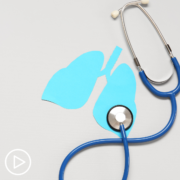
Understanding Non-Small Cell Lung Cancer: Types, Biomarkers, and Treatment Insights |

Navigating Lung Cancer Biomarker Testing | Challenges and Solutions for Timely Access |

|
Transcript:
Lisa Hatfield:
So, Dr. Manley, are there any promising approaches or interventions aimed at reducing biomarker disparities that you’ve currently been exploring or are advocating for?
Dr. Eugene Manley:
I will take several angles on this. One thing is there has to be much more community engagement and involvement and really going to community groups, whether they’re faith-based, whether they’re barbershops, really going out where people are and letting them know about lung cancer, lung cancer disparities, biomarker testing, what you can do. The other way is also going to conferences where there are more diverse scholars that are attending. So a lot of these are STEMM meetings. They may not be specific in lung cancer, but if you can go out there and get the word out about lung cancer and the disparities, then they can go back to their families and talk about, you know, screening and testing and making sure that their family members are aware.
And then, you know, we just published a paper recently that shows the upstream part of biomarker testing is where are we starting at with our cell line? We just did a review of all the lung cancer cell lines. Of over 800 cell lines, majority were European-based. Only 31 cell lines in total were from Black African American populations. None were from Hispanic, none were from Native American, Pacific Islander, none from Alaska Native.
So just think about this. If that is our starting material for all of our biomarker testing and TCGA and databases, then everything we’re developing is on a population that already has great access and outcomes. But they don’t have the greatest disparities. So then you’re getting through doing all these trials, and then you have biomarkers, and you have immunotherapies coming out, and then you’re seeing adverse events in these diverse populations at the end because you don’t have the starting material.
Lisa Hatfield:
And, Dr. Sabari, after hearing Dr. Manley’s comments about that, how do you…or do you know of any approaches or interventions that are aimed at reducing these biomarker disparities? Because maybe they aren’t being acknowledged yet. Maybe they’re only being seen in certain populations.
Dr. Joshua Sabari:
Yeah, I think Dr. Manley hit it on the head. First off, we don’t even know the correct or true numbers for certain mutations in specific patient populations. And I just read an article about patients from Latin America, different rates of EGFR, ALK, and other mutations. You can imagine a study population from Africa, for example. And then obviously studying a population of Black Americans here in the United States as well.
We know that most of the cell lines, most of the data that we’ve had, particularly TCGA (Tumor Cell Genome Atlas) is from a Caucasian or North European patient population. So I think we need to do better in that sense. I think equally as important, are clinical trial enrollment needs to diversify. Again, it’s mostly women. It’s mostly Caucasian women. We have very, very low rates of Hispanic patients enrolled on clinical trials, Blacks enrolled on clinical trials.
So I think we need to do better in that sense. One thing that we’ve really pushed for in academic medicine is to at least report who is being enrolled on trials so that we can understand is this data generalizable to my own clinical practice? And oftentimes if you look at the clinical characteristics of patients enrolled on the trial, it likely does not match what you see in your own practices.
So we need to do better in that sense. So I think the FDA, and especially pharmaceutical companies, are clearly looking to expand and broaden their inclusion criteria and also access to patients so that we can actually have a more diverse patient population that represents our country enrolled on these trials.
Share Your Feedback
Create your own user feedback survey
When Should Lung Cancer Patients Receive Biomarker Testing?
When Should Lung Cancer Patients Receive Biomarker Testing? from Patient Empowerment Network on Vimeo.
Biomarker testing is vital for non-small cell lung cancer (NSCLC) patients, but when should it happen? Expert Dr. Joshua Sabari from NYU Langone discusses cancer cell mutations and ideal timing for biomarker testing for the best patient care.
Download Resource Guide | Descargar guía de recursos
See More from [ACT]IVATED NSCLC Biomarkers
Related Resources:
Transcript:
Lisa Hatfield:
And just from the patient perspective, does a patient need to be tested for these biomarkers throughout the course of their treatment, or is it done initially upon diagnosis or before second-line treatment?
Dr. Joshua Sabari:
Yeah, that’s a great question. You know, most mutations are clonal, meaning that they start in the original cancer cell and then the subsequent cells, daughter or son cells, also have that same mutation. So I would recommend doing next-generation sequencing up front in all patients. Now, some people have a specific mutation that we block with a targeted therapy. It could be pills. It could be an infusional targeted therapy. And that might change the sort of milieu or landscape of that mutational profile. So subsequently, after treatment, you may see acquired resistance or secondary mutations that will prevent the therapies from being effective. In those cases, I do recommend re-profiling.
So the most common example in lung cancer is the EGFR mutation, stands for epidermal growth factor receptor. We know that this mutation occurs in 20 to 25 percent of people diagnosed with non-small cell lung cancer. If you’re matched to a targeted therapy and don’t unfortunately have progression of disease, it may be very helpful to re-biopsy or re-sequence using both tissue and plasma to help us guide subsequent therapy. But if you do not have a targeted mutation and you’re treated with either chemotherapy and immunotherapy or immunotherapy alone, re-biopsy may not be as helpful in matching to further therapy.
Share Your Feedback
Create your own user feedback survey
Navigating Lung Cancer Biomarker Testing | Challenges and Solutions for Timely Access
Navigating Lung Cancer Biomarker Testing | Challenges and Solutions for Timely Access from Patient Empowerment Network on Vimeo.
To achieve accurate biomarker data for lung cancer patients, what are challenges and solutions? Expert Dr. Joshua Sabari from NYU Langone discusses challenges that can arise during the biomarker testing process, solutions to overcome the challenges, and proactive advice to help ensure optimal patient care.
[ACT]IVATION TIP
“…not only know your mutation, but speak up for yourself. Speak up for your loved one. Make sure that the correct testing is done and that there is sufficient tissue, both for blood and tissue from the biopsy, to do the correct testing to allow us to potentially match people to the best treatments available.”
Download Resource Guide | Descargar guía de recursos
See More from [ACT]IVATED NSCLC Biomarkers
Related Resources:

Understanding Non-Small Cell Lung Cancer: Types, Biomarkers, and Treatment Insights |

|

Equity in Action | Addressing Biomarker Disparities in Lung Cancer |
Transcript:
Lisa Hatfield:
So, Dr. Sabari, this is a multi-part question here, so I’ll break it down a little bit. What are some of the main challenges in collecting accurate biomarker data, and how can researchers overcome these challenges? And considering the challenges that oncologists face in retrieving testing results at second-line treatment, what technological advancements or procedural changes could streamline the process and ensure timely access to biomarker testing results?
Dr. Joshua Sabari:
So when we talk about biomarker testing, we’re generally talking about testing the tissue, as well as sometimes testing blood or plasma. And it’s important that if you have a good and accurate biopsy with sufficient tissue, that then gives us the ability to select or do the correct biomarker testing. So that’s first and foremost, you know, fine needle aspiration, small aspirations may give us insufficient tissue. You know, whereas if you do a core needle biopsy, whether it be percutaneous through the chest with an image or bronchoscopically through the mouth with a camera, we’re able to get a large sample of tissue.
This will give us the amount of tissue needed to do the correct biomarker testing. We call it next generation sequencing or short for NGS, where we’re able to actually identify the mutations or abnormalities in your DNA. The other type of test we can do is on plasma, where we sometimes call it a liquid biopsy. That’s a simple blood test where, you know, a team will draw about two 10 cc blood tubes, where we’re then able to sequence, you know, DNA in your blood to help identify these alterations.
So having sufficient tissue or having the blood drawn, that’s important.
But then also having your physician and your clinician and healthcare team order the appropriate test. You know, it’s unfortunate. A lot of folks that I see in my practice have not had adequate testing done in the frontline setting. Oftentimes, clinicians will be in a rush to start systemic treatment, both because patients are symptomatic, but also because they want to get going with treatment for patients. So, you know, stopping your physician, your team and saying, hey, what is my mutational profile? What is my mutational status is an extremely important discussion to have with your clinician. So a lot of times we only see this being done in the second-line setting.
So having that information up front could allow you and your family members to be matched to the best possible therapy. Now, if you’ve started a treatment and you don’t have genetic testing or molecular testing done in the front line, I would then have it done in the second-line setting. So one of my activation tips here is not only know your mutation, but speak up for yourself. Speak up for your loved one. Make sure that the correct testing is done and that there is sufficient tissue, both for blood and tissue from the biopsy, to do the correct testing to allow us to potentially match people to the best treatments available.
Share Your Feedback
Create your own user feedback survey
Understanding Non-Small Cell Lung Cancer: Types, Biomarkers, and Treatment Insights
Understanding Non-Small Cell Lung Cancer: Types, Biomarkers, and Treatment Insights from Patient Empowerment Network on Vimeo.
How can non-small cell lung cancer (NSCLC) patients be empowered when newly diagnosed? Expert Dr. Joshua Sabari from NYU Langone discusses what he shares about NSCLC incidence rates, histology, and biomarkers with patients and families.
[ACT]IVATION TIP
“…know what type of cancer you have, the histology. Whether it be adenocarcinoma or squamous cancer. And equally as important, know your biomarker, what mutation is driving your cancer and what PD-L1 expression your tumor harbors.”
Download Resource Guide | Descargar guía de recursos
See More from [ACT]IVATED NSCLC Biomarkers
Related Resources:

Navigating Lung Cancer Biomarker Testing | Challenges and Solutions for Timely Access |

|

Equity in Action | Addressing Biomarker Disparities in Lung Cancer |
Transcript:
Lisa Hatfield:
Dr. Sabari, how do you explain non-small cell lung cancer to your patients and their care partners and families?
Dr. Joshua Sabari:
Yeah, so non-small cell lung cancer is a common cancer in the United States. It’s actually the third most common cancer. And really, you know, non-small cell lung cancer makes up multiple different histologies or types of cancer in the lung. The most common being adenocarcinoma, which is probably about 60 percent to 70 percent of non-small cell. We also hear about squamous cell cancer. And what this means is what is the original cell where the cancer arose? So adenocarcinomas occur in gland cells.
Whereas squamous cancers occur in cells such as the lining part of the lung. And it’s important to know what type of cancer you have because these are treated differently. And when you think about non-small cell lung cancer, we said there are many different ways that people can present. Some people can have shortness of breath, cough, you know, and weight loss. Whereas other people may have no symptoms at all.
So again, the important thing here is that lung cancer can be diagnosed in anybody. All you really need to have is lungs. We see lung cancer in people who’ve smoked in the past, but we also see lung cancer in people who’ve never smoked. And that brings me to a really important point. Once we understand the histology, the type of cancer that it is, we then want to understand some of the biomarkers, right? What are biomarkers?
Biomarkers are distinct sort of entities that help us better understand things about your cancer. And allow us to potentially match people to therapies. So two biomarkers that we generally think about, one is molecular or mutational biomarkers. These are the mutations or abnormalities that led to the cancer. Two kinds of mutations. One is a germline mutation, which is inherited from mom and dad and has a risk of being passed on to your children.
These are uncommon in lung cancer. The second type is called a somatic mutation. And these are mutations that are acquired from the environment, from smoking, for example, from pollution, from radon. And these are not generally inherited mutations. So really important to understand mutational profile and ask your doctor, what is my mutation? Because we can then match people to targeted therapies. The second biomarker that is really important is something called PD-L1 or programmed death-ligand 1. I know it sounds exotic.
But that’s a biomarker that helps us guide how likely immunotherapy will work in your cancer. If the PD-L1 expression is high, greater than 50 percent, immunotherapy may be a very good option. If the PD-L1 expression is low, immunotherapy may sometimes be used, but more commonly in combination with chemotherapy. So my activation tip here is know what type of cancer you have, the histology. Whether it be adenocarcinoma or squamous cancer. And equally as important, know your biomarker, what mutation is driving your cancer and what PD-L1 expression your tumor harbors.
Share Your Feedback
Create your own user feedback survey



